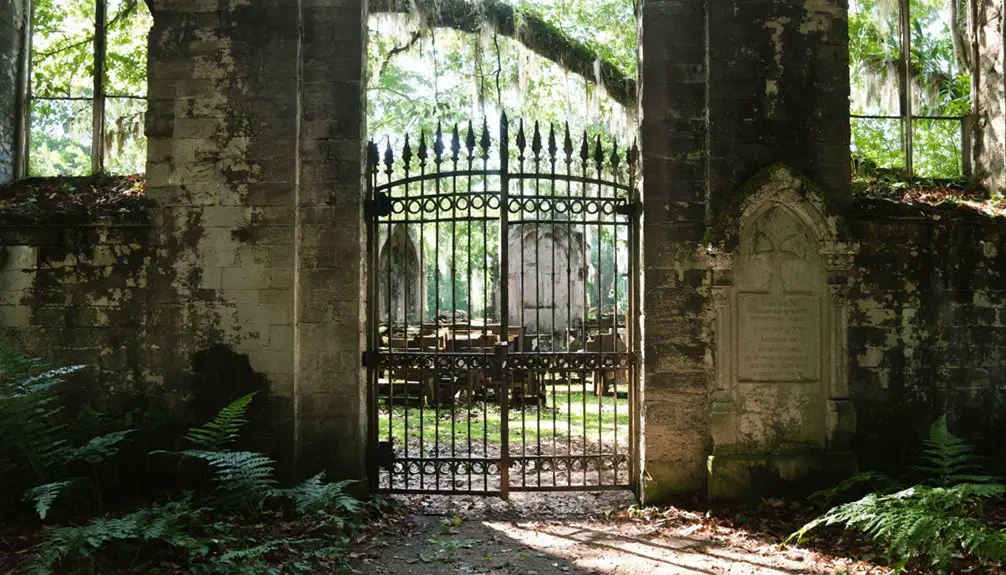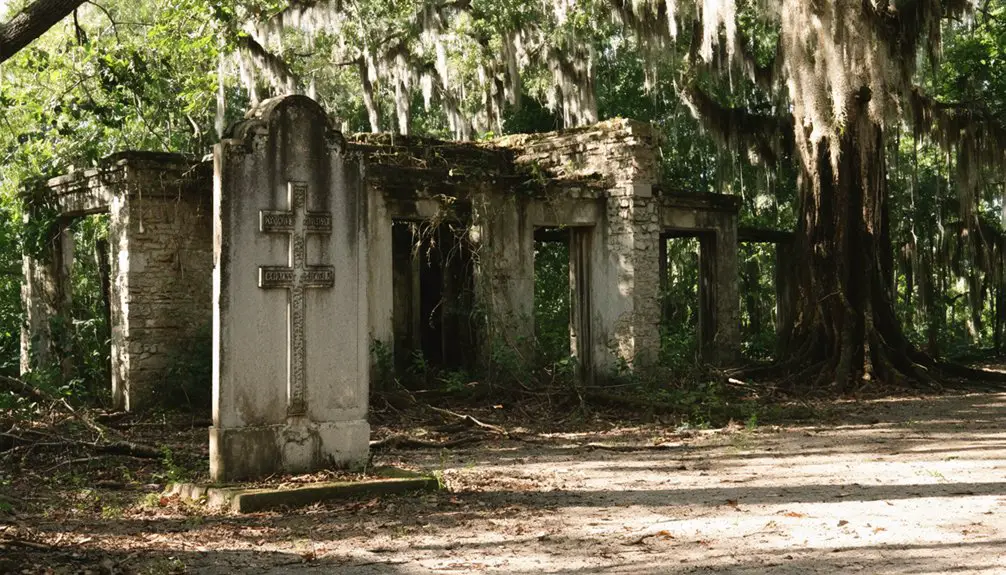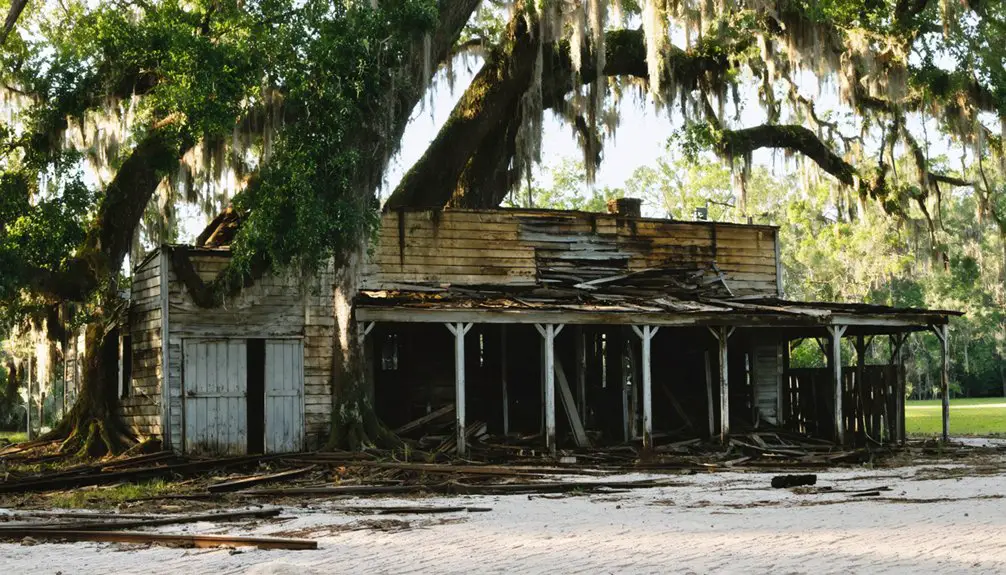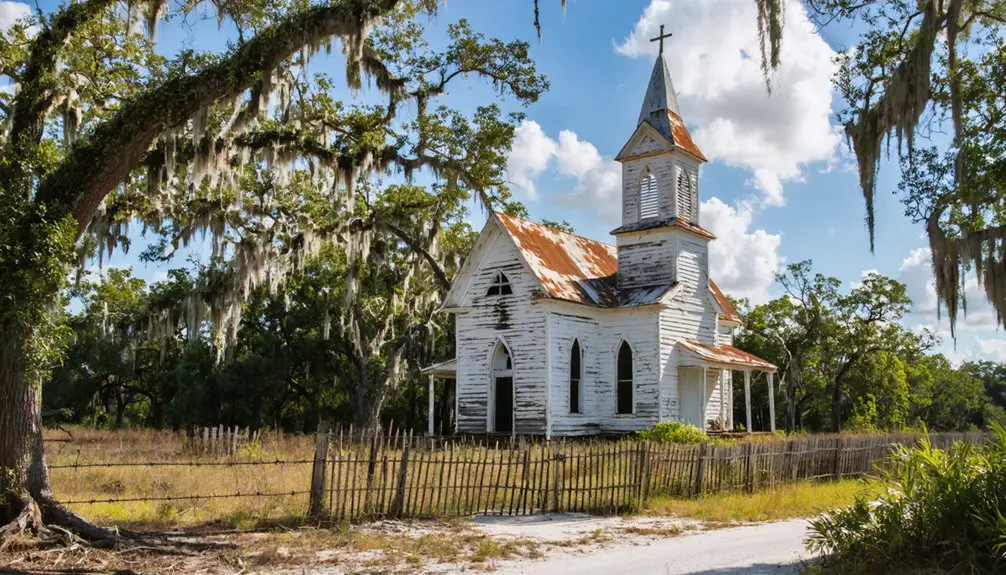You’ll find Acton’s ghost town story between Lake Parker and Bonny Lake in Polk County, where British investors established an ambitious settlement in 1884. The town quickly flourished with a railroad depot, hotel, stores, and Episcopal church, reaching 200 residents who enjoyed distinctly British activities like polo and fox hunting. After the mysterious burning of its depot and the devastating Great Freeze of 1894-95, Acton’s remaining residents migrated to Lakeland, leaving behind intriguing tales of rivalry and lost dreams.
Key Takeaways
- Acton was a British settlement founded in 1884 in Polk County, Florida, that grew to 200 residents before becoming a ghost town.
- The town thrived as a railroad hub with hotels, stores, and an Episcopal church until its rapid decline began in 1889.
- A mysterious depot fire, combined with growing rivalry from nearby Lakeland, severely impacted Acton’s status as a transportation center.
- The Great Freeze of 1894-1895 destroyed local crops and triggered mass exodus, leading to the town’s eventual abandonment.
- Today, Acton exists only in historical records, having completely disappeared after its residents relocated primarily to Lakeland.
A British Settlement Takes Root in Florida
As British influence expanded into Florida during the late 19th century, the town of Acton emerged in 1884 as a distinctly English settlement in Polk County.
Named after the renowned English historian Lord Acton, the town’s development was driven by ambitious British investors and speculators who’d seized opportunities following Hamilton Disston’s massive 4-million-acre land purchase in Florida.
British ambition and capital shaped Acton’s founding after Disston’s Florida land deal, with the town bearing a prominent English historian’s name.
The Florida Mortgage & Investment Company Limited, led by English officers Robert W. Hanbury and Piers Eliot Warburton, spearheaded settlement patterns by marketing Acton’s acreage back in England. Much like its Massachusetts namesake which spans 20.3 square miles, this Florida settlement covered a substantial area of fertile land.
You’ll find their influence reflected in the town’s early infrastructure, including its pioneering church and strategic railroad depot. Like many similar entries, the town required careful disambiguation to distinguish it from other locations sharing the Acton name.
The settlement’s British character was further cemented when Warburton himself relocated to Acton after his marriage in 1889.
The Rise of a Pioneer Railroad Town
While the South Florida Railroad was expanding across central Florida in the 1880s, Acton emerged as a pivotal stop along its route.
You’d find the town strategically positioned near major lakes, where railroad innovation was transforming the landscape. The establishment of Acton’s depot, one of the earliest in the region, preceded even Lakeland’s facility and sparked early commerce in the area.
English investors, including those associated with the Florida Mortgage & Investment Company Limited, saw potential in this railroad town. The town had two lodging establishments, the Acton House and Lake House, to accommodate the growing number of visitors. The town’s prosperity was short-lived when its railroad depot burned down.
You could witness up to 25 trains daily passing through the area, bringing settlers and speculators enthusiastic to capitalize on the boom. The railroad’s presence promised prosperity, connecting Acton to larger markets and establishing it as a significant transportation hub in Polk County.
Early Life and Notable Achievements
You’ll find Acton’s early pioneers establishing a distinctly British community in 1884, complete with polo matches, fox hunting, and traditional English social customs that set them apart from other Florida settlements.
At its height, the community reached a population of 200 residents who actively participated in maintaining their British heritage and customs.
The town’s infrastructure quickly expanded to include essential services like a hotel, sawmill, stores, and an Episcopal church that would later be relocated to Lakeland.
The first railroad depot in the area made Acton a significant stop on the South Florida Railroad line.
The railroad depot‘s establishment positioned Acton as an early regional transport hub, marking one of the settlement’s most significant achievements before its eventual decline.
Pioneer Settlement Activities
During the settlement’s formative years from 1884 to 1889, Acton’s pioneers established critical infrastructure and engaged in diverse economic activities. You’d have found English settlers building a post office, railroad depot, and Episcopal church while laying out platted lands for development.
These determined pioneers tackled settlement challenges through small-scale farming operations, focusing on citrus and strawberry cultivation that proved well-suited to local conditions.
The railroad depot became Acton’s lifeline, predating even Lakeland’s facilities and positioning the settlement as an early regional hub. Early settlers often participated in hands-on classes to learn traditional skills and crafts essential for daily life.
Pioneer farming efforts expanded as settlers demonstrated the profitability of various crops, particularly after 1887 when the Marsh Seedless Grapefruit was introduced nearby.
Unfortunately, by 1889, many residents had begun relocating to Lakeland as economic forces shifted.
Religious and Social Life
As English settlers established their new community, religious and social life in Acton centered around the Anglican-inspired All Saints Episcopal Church, built in the late 1880s.
You’d find religious gatherings and community events regularly held at the church, which served as both a spiritual and social hub for the town’s residents. Local craftsman Joseph Harris contributed by creating hardware for the first meeting house.
Beyond church activities, you could join in distinctly British social pursuits like polo matches and fox hunting, reflecting the settlers’ cultural heritage.
The town square, hotel, and stores provided additional venues for socializing. Community events often showcased British traditions in dress and behavior, setting Acton apart from neighboring settlements like Lakeland, which they considered their nemesis.
Infrastructure Development Milestones
When Hamilton Disston purchased 4 million acres of Florida land in the early 1880s, he set the stage for Acton’s rapid infrastructure development.
The South Florida Railroad‘s establishment of a depot made Acton a crucial transportation infrastructure hub before Lakeland existed. You’d have seen English settlers arriving by 1883, drawn by the Florida Mortgage & Investment Company Limited’s promotional efforts.
The town’s community connectivity flourished with the opening of its post office in 1884 and the construction of the region’s first church.
Within a one-square-mile area between Lake Parker and Bonny Lake, Acton developed roads, housing, and basic utilities.
However, this growth proved short-lived – by 1889, the post office closed as businesses and residents migrated to Lakeland, marking the beginning of Acton’s decline.
The Episcopal Church and Religious Heritage

Shortly after Acton’s establishment, English settlers founded All Saints’ Episcopal Church in 1884, marking the first Episcopal congregation in the region.
Built on East Gary Road between Lake Parker and Lake Bonny, the church bore the name of Lord Acton, reflecting the settlers’ British roots.
Between two shimmering lakes, the settlers honored their homeland by naming their church after Britain’s Lord Acton.
The devastating freeze of 1890 forced a dramatic change in the church’s Episcopal heritage. The church remained closed for three years following the economic devastation.
When the local economy collapsed, Rev. John H. Weddell orchestrated the church’s relocation to Lakeland in 1892, moving the entire structure by ox team to Lemon and Massachusetts Avenues.
Under his 27-year leadership, the congregation flourished, eventually becoming a self-supporting parish.
Though the original wooden structure was replaced in 1923, you can still find pieces of Acton’s religious legacy preserved in St. Mary’s Chapel, including Rev. Weddell’s hand-carved altar.
The new church building was designed in Spanish Revival style, featuring distinctive architectural elements that still stand today.
Battle for Regional Dominance With Lakeland
The rivalry between Acton and Lakeland intensified in the late 1800s as both towns vied for regional supremacy. Early rivalry dynamics favored Acton, which boasted both a church and vital railroad depot south of Lake Parker.
However, the mysterious burning of Acton’s depot marked a turning point in the competition. Lakeland’s strategic victory in securing a new, larger railway station transformed the transportation impact of the region.
You’ll find that by the mid-1890s, Lakeland had become a bustling hub with 25 daily trains, while Acton’s influence waned. With superior elevation at 227 feet and growing infrastructure, Lakeland attracted more businesses and settlers. Today, Lakeland continues its impressive growth as Polk County’s fastest growing region in the United States.
The town’s dominance in citrus and phosphate industries, coupled with its enhanced rail connectivity, sealed Acton’s fate. By 1906, Acton had vanished, leaving Lakeland as the undisputed regional power.
Natural Disasters and Economic Setbacks

As devastating winter storms struck Florida in 1894-1895, Acton’s fate was sealed by what became known as the Great Freeze. This natural disaster destroyed essential crops and devastated the local economy, forcing most of the town’s 200 residents to abandon their homes.
The economic setbacks that crippled Acton included:
- Complete destruction of agricultural production
- Mass exodus of residents to nearby Lakeland
- Permanent loss of critical business operations
You’ll find that Acton was already struggling before the freeze, having lost its post office in 1889 and experiencing the relocation of its Episcopal church to Lakeland.
The town’s dependence on agriculture and land speculation left it vulnerable to environmental catastrophes. When combined with the railroad depot’s destruction by fire, these challenges proved insurmountable for the once-promising English settlement.
The Mystery of the Railroad Depot Fire
While natural disasters played a significant role in Acton’s downfall, an earlier event had already set the town’s decline in motion.
In the late 1880s, the town’s railroad depot – a crucial hub for cotton shipments, telegraph communications, and express services – burned down under mysterious circumstances.
The brick structure, with its wooden gables and 40-foot cotton platform, was destroyed completely. Various depot fire theories emerged, including arson speculation fueled by the intense rivalry between Acton and nearby Lakeland.
You’ll find no definitive answers about who started the fire, but its impact was clear. Lakeland seized the opportunity, building a larger, more modern depot that attracted increased rail traffic.
Legacy Between Two Lakes

Nestled between Lake Parker and Bonny Lake, Acton’s English-influenced settlement carved out a distinctive cultural enclave in late 19th century Florida.
You’ll find this one-square-mile ghost town’s legacy echoing through the cultural influences of its British settlers, who brought their refined traditions of polo and fox hunting to the Florida wilderness.
The town’s economic shifts reflected its ambitious but short-lived prominence:
- A strategic railroad depot made Acton an early transportation hub
- The first Episcopal church in the region established religious foundations
- A thriving commercial district supported hotels, stores, and a sawmill
You can still sense Acton’s spirit in Interlachen Park’s historical marker, though the great freeze of 1894-1895 ultimately scattered its 200 residents and sealed the town’s fate.
English Investment and Land Development
The story of Acton begins with ambitious English investors who saw opportunity in Florida’s vast wilderness. Their investment strategies centered on The Florida Mortgage & Investment Company Limited, led by Robert W. Hanbury and Piers Eliot Warburton.
Following Hamilton Disston’s massive 4-million-acre purchase that cleared Florida’s debt, these British speculators swooped in to acquire prime parcels.
You’ll find their land speculation efforts were calculated and swift. They established Acton in 1883-1884, naming it after Lord Acton and marketing parcels back in England.
The consortium’s master plan included strategic railroad development to boost land values. They secured a South Florida Railroad depot and attracted English families to settle the one-square-mile town between Lake Parker and Bonny Lake, creating a foothold in Florida’s emerging citrus belt.
Tales From Florida’s Lost Communities
Once home to a vibrant English settlement, Acton flourished as a cultural outpost between Lake Parker and Bonny Lake from 1884 to 1889.
Between two pristine lakes, Acton shone briefly as a British cultural gem in Florida’s frontier landscape during the 1880s.
This lost community reflected British traditions through polo matches and fox hunting, while serving as Lakeland’s chief rival during its brief existence.
Your journey through Acton’s history would’ve revealed:
- A bustling railroad depot that sparked the town’s initial growth before its mysterious destruction by fire
- The first Episcopal church in the region, later relocated to Lakeland as Acton’s population dispersed
- A thriving commercial district with a hotel, sawmill, and stores serving around 200 residents
Frequently Asked Questions
Are There Any Remaining Structures or Ruins From Acton Visible Today?
You won’t find any remaining ruins in Acton today. The town’s historical significance lives on through a marker in Interlachen Park, while its original buildings were either relocated or lost to time.
What Happened to the Original Residents After Acton’s Decline?
After the devastating 1894 freeze wiped out 200 residents’ livelihoods, you’d find most relocated to thriving Lakeland, carrying their English traditions, church community, and cultural practices with them while seeking fresh economic opportunities.
How Many People Lived in Acton During Its Peak Population?
You’ll find that during its peak population dynamics, about 200 residents called this place home. This historically significant number supported local amenities like stores, a hotel, and church before decline began.
Did Acton Have Its Own School System During Its Brief Existence?
You won’t find any documented school history for this town. While it’s fascinating that 200 people called it home, there’s no evidence they ever established their own education impact through formal schooling.
What Types of Businesses and Industries Operated in Acton Besides Railroads?
You’d find hotels like Acton House and Lake House, a post office, timber industry operations, agricultural practices, and real estate businesses driven by English investors speculating on Florida land.
References
- https://en.wikipedia.org/wiki/Acton
- https://laltoday.6amcity.com/acton-florida-lakeland-fl-nemesis
- https://citruslandfl.blogspot.com/2019/08/first-train-to-acton-of-polk-county.html
- https://ghosttownadventures.wordpress.com/2024/07/07/acton/
- https://commons.wikimedia.org/wiki/File:Acton_Community_HM_at_Interlachen_Park-3.jpg
- https://archive.org/stream/historyoftownofa00phal/historyoftownofa00phal_djvu.txt
- https://www.lakelandgov.net/departments/library/lakeland-history-room/brief-history-of-lakeland/
- https://westpascomuseum.org/pascohistory/historicalinformation/communities/trilby/trilby9/
- https://www.wikiwand.com/en/articles/Acton
- https://panhandlepioneer.org



